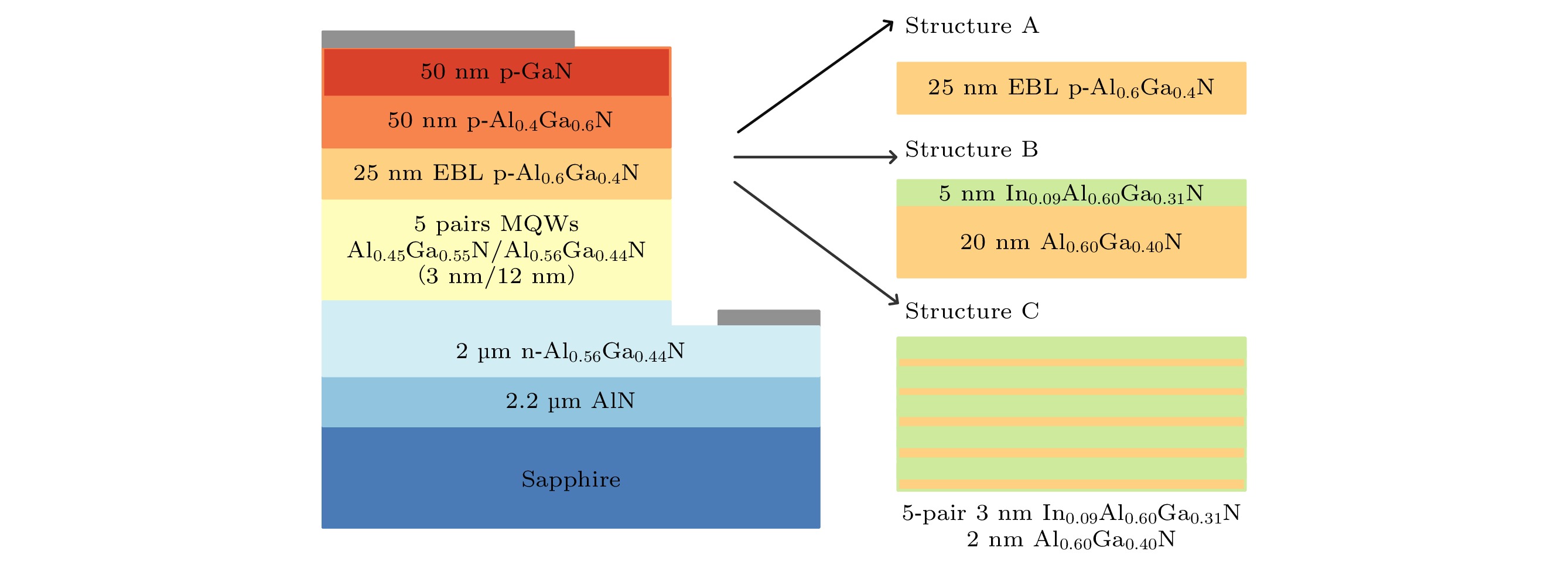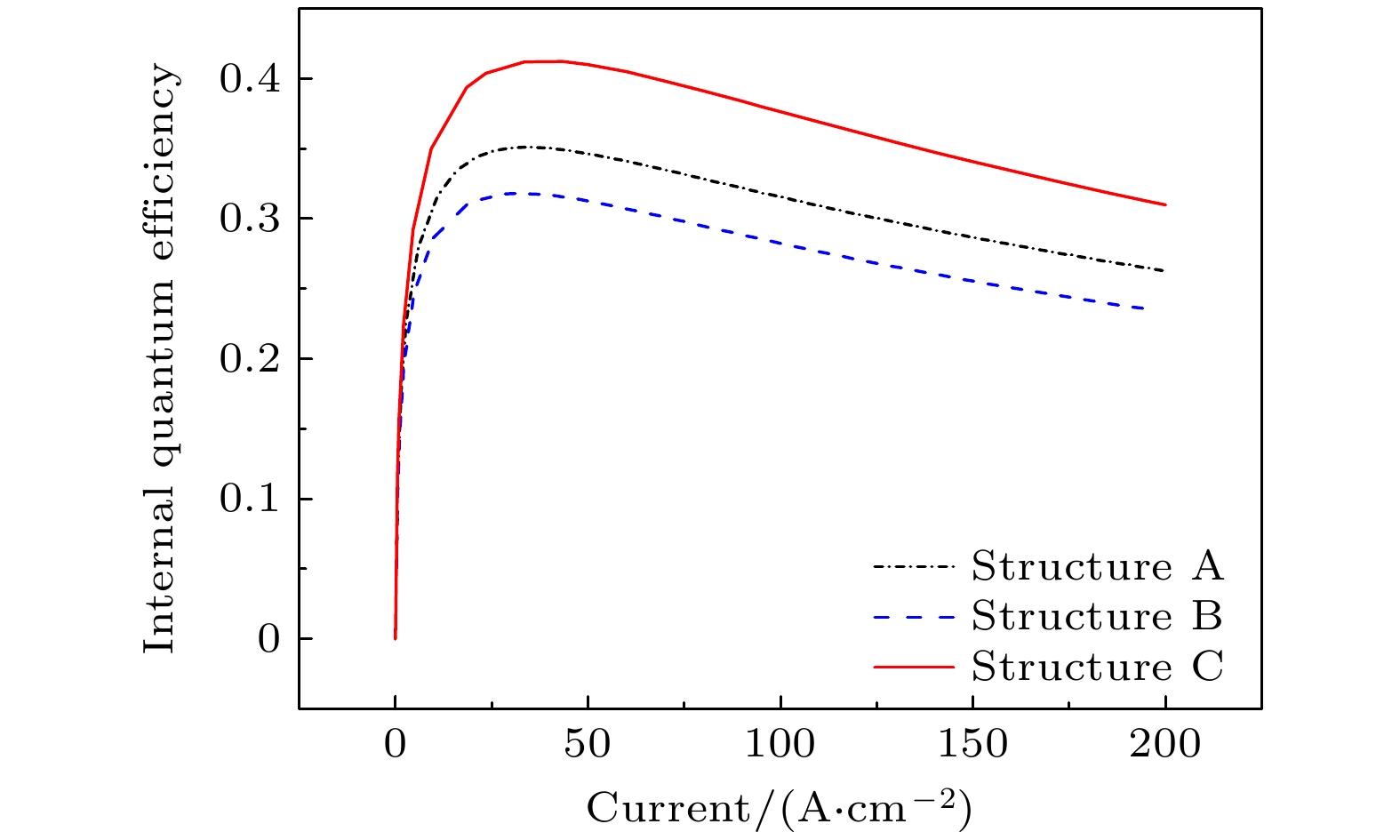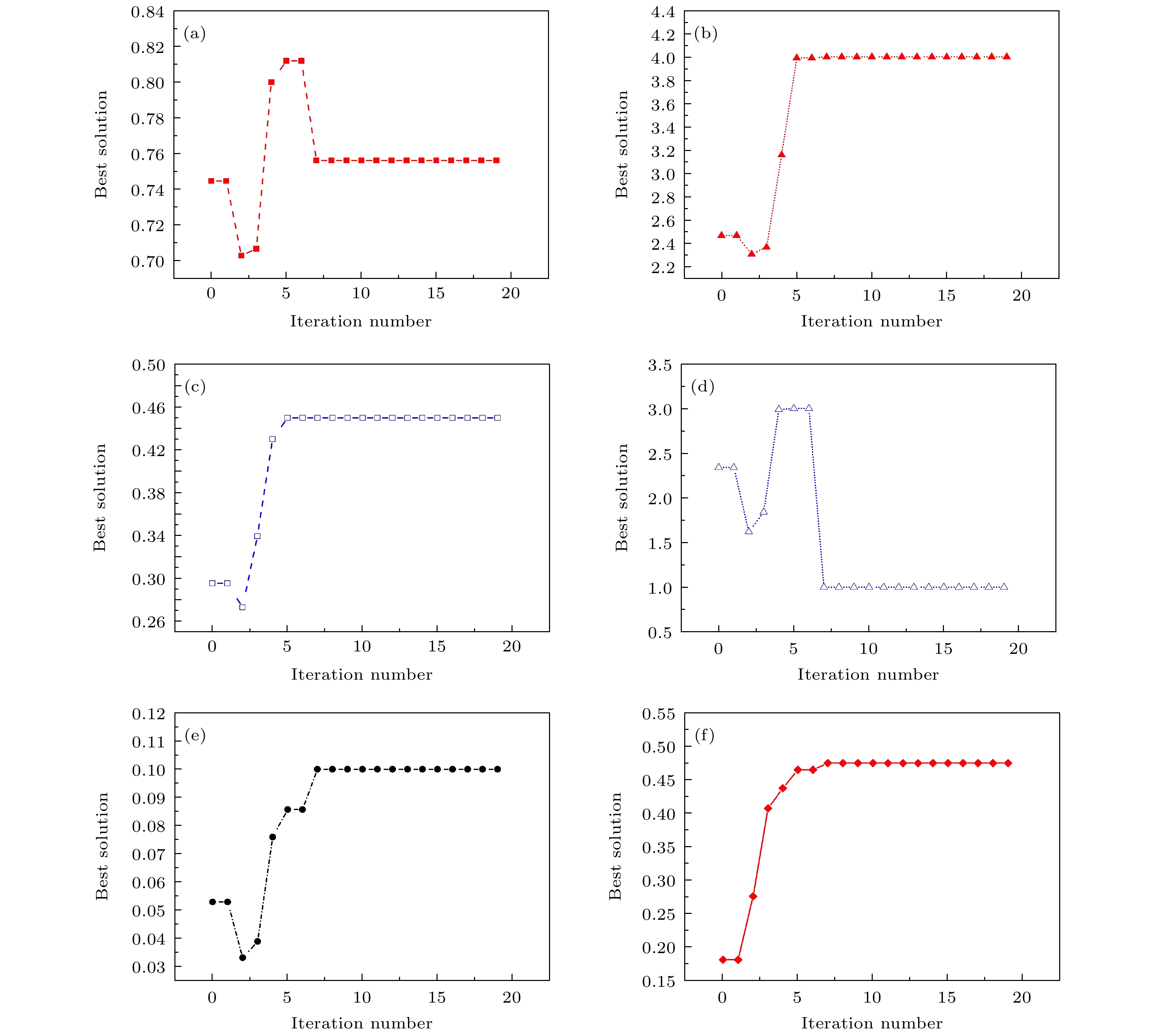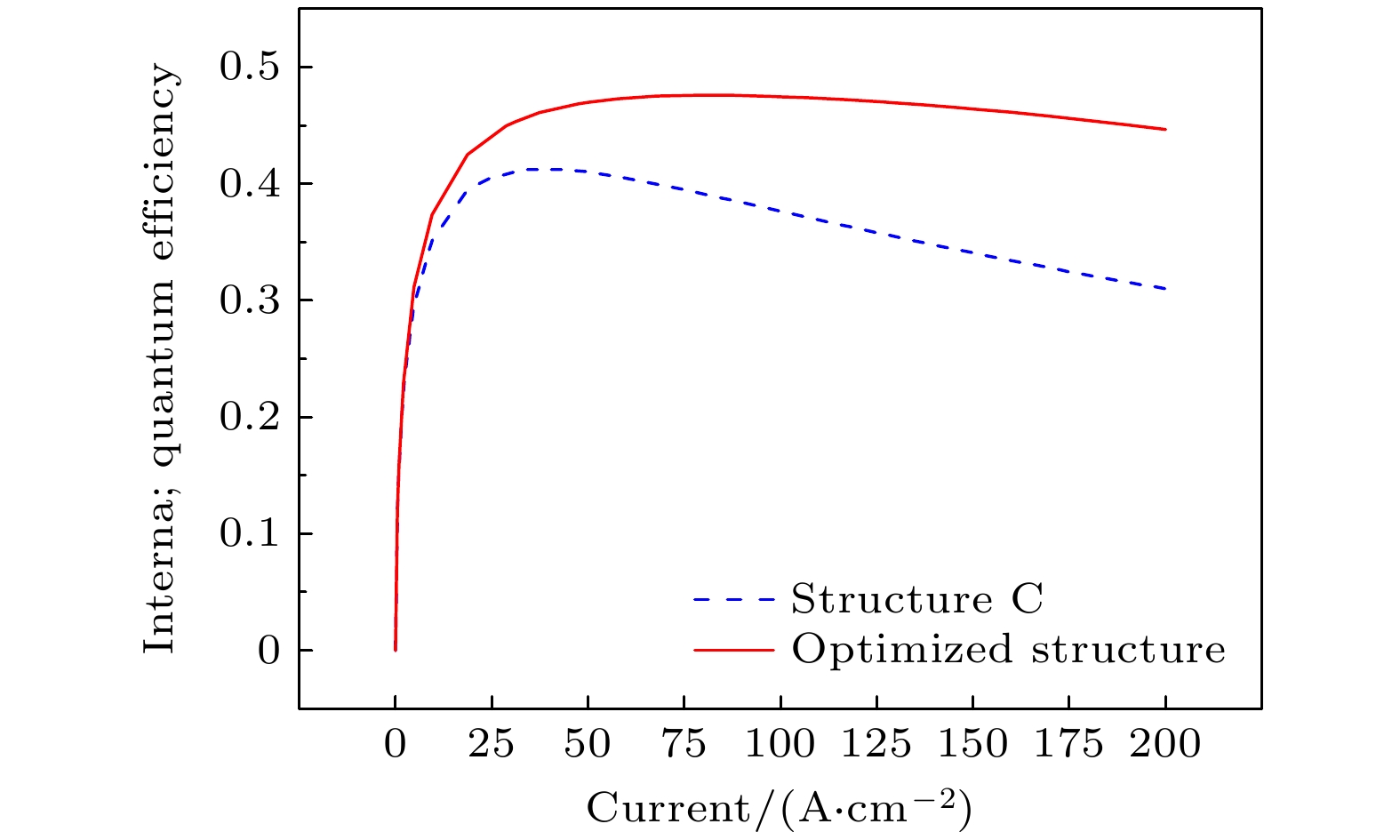-
为了提高AlGaN基深紫外发光二极管(light emitting diode, LED)的内量子效率(internal quantum efficiency, IQE), 本文采用了基于InAlGaN/ AlGaN超晶格的电子阻挡层(electron blocking layer, EBL)结构, 结果表明与传统的单层和双层电子阻挡层结构相比, 超晶格EBL结构能够有效提高LED的内量子效率. 在此基础上, 本文提出了基于JAYA智能算法的LED结构优化方法, 应用该方法以最大化内量子效率为目标, 对InAlGaN/AlGaN超晶格EBL结构进行优化设计. 结果表明, 采用优化超晶格EBL结构后电子泄露和空穴注入问题都有所改善, 在200 mA电流注入时深紫外LED的内量子效率比采用单层结构EBL提高了41.2%.AlGaN-based deep-ultraviolet light-emitting diodes (DUV LEDs) are widely used in sterilization, sensing, water purification, medical treatment, non-line of sight (NLOS) communication and many other fields. Especially it has been reported that the global novel coronavirus (COVID-19) can be effectively inactivated by the DUV light with a wavelength below 280 nm (UVC) within a few seconds, which has also attracted great attention. However, the external quantum efficiency (EQE) of UVC LED is still at a low level, generally not more than 10%. As an important component of EQE, internal quantum efficiency (IQE) plays a crucial role in realizing high-performance DUV-LED. In order to improve the IQE of AlGaN-based DUV-LED, this work adopts an electron blocking layer (EBL) structure based on InAlGaN/AlGaN superlattice. The results show that the superlattice EBL structure can effectively improve the IQE compared with the traditional single-layer and double-layer EBL structure for the DUV-LED. On this basis, the optimization method based on JAYA intelligent algorithm for LED structure design is proposed in this work. Using the proposed design method, the InAlGaN/AlGaN superlattice EBL structure is further optimized to maximize the LED’s IQE. It is demonstrated that the optimized superlattice EBL structure is beneficial to not only the suppression of electron leakage but also the improvement of hole injection, leading to the increase of carrier recombination in the active region. As a result, the IQE of the DUV-LED at 200 mA injection current is 41.2% higher than that of the single-layer EBL structure. In addition, the optimized structure reduces IQE at high current from 25% to 4%. The optimization method based on intelligent algorithm can break through the limitation of the current LED structure design and provide a new method to improve the efficiency of AlGaN-based DUV-LED.
-
Keywords:
- deep ultraviolet light emitting diode /
- internal quantum efficiency /
- intelligent optimization algorithm /
- electron leakage
[1] Ren Z J, Yu H B, Liu Z L, et al. 2020 J. Phys. D Appl. Phys. 53 073002
 Google Scholar
Google Scholar
[2] Wang J X, Yan J X, Guo Y A, et al. 2015 Sci Sin. Phys. Mech. Astron. 45 067303
 Google Scholar
Google Scholar
[3] Khan A, Balakrishnan K, Katona T 2008 Nat. Photonics 2 067303
 Google Scholar
Google Scholar
[4] Kneissl M, Seong T Y, Han J, Amano H 2019 Nat. Photonics. 13 233
 Google Scholar
Google Scholar
[5] Park J S, Kim J K, Cho J, Seong T Y 2017 ECS J. Solid State Sci. Technol. 6 Q42
 Google Scholar
Google Scholar
[6] Xia Z H, Liang S H, Li B Q, Wang F, Zhang D M 2021 Optik 231 166392
 Google Scholar
Google Scholar
[7] Storm N, McKay L G A, Downs S N, et al. 2020 Sci. Rep. 10 22421
 Google Scholar
Google Scholar
[8] Hirayama H, Tsukada Y, Maeda T, Kamata K 2010 Appl. Phys. Express 3 031002
 Google Scholar
Google Scholar
[9] Islam N U, Usman M, Khan S, Jamil T, Rasheed S, Ali S, Saeed S 2021 Optik 248 168212
 Google Scholar
Google Scholar
[10] Usman M, Malik S, Hussain M, Jamal H, Khan MA 2021 Opt. Mater. 112 110745
 Google Scholar
Google Scholar
[11] Mondal R K, Chatterjee V, Pal S 2020 Semicond. Sci. Technol. 35 055031
 Google Scholar
Google Scholar
[12] Wang Y F, Mussaab I Niass, Wang F, Liu Y H 2020 Chin. Phys. B 29 480
[13] Jamil T, Usman M, Jamal H, Khan S, Rasheed S, Ali S 2021 J. Electro. Mater. 50 5612
 Google Scholar
Google Scholar
[14] Rao R V 2016 Int. J. Ind. Eng. Comp. 7 19
[15] Gao K Z, Yang F J, Zhou M C, Pan Q K, Suganthan P N 2019 IEEE Trans. Cybernetics. 49 1944
 Google Scholar
Google Scholar
[16] Gao K Z, Zhang Y C, Sadollah A, Lentzakis A, Su R 2017 Swarm. Evol. Comput. 37 58
 Google Scholar
Google Scholar
[17] Mymrin V F, Bulashevich K A, Podolskaya N I, et al. 2005 Phys. Status Solidi C 2 2928
 Google Scholar
Google Scholar
[18] Kim S J, Kim T G 2014 Phys. Status Solidi A 211 656
 Google Scholar
Google Scholar
[19] Kuo Y K, Chang J Y, Chen F M, Shih Y H, Chang H T 2016 IEEE Quantum Elect. 52 3300105
 Google Scholar
Google Scholar
[20] Xing Z Q, Zhou Y J, Liu Y H, Wang F 2020 Chin. Phys. Lett. 37 027302
 Google Scholar
Google Scholar
[21] Vurgaftman I, Meyer J R, Ram-Mohan L R 2001 J. Appl. Phys. 89 5815
 Google Scholar
Google Scholar
[22] Chuang S L, Chang C S 1996 Phys. Rev. B 54 2491
 Google Scholar
Google Scholar
[23] Dugdale D J, Brand S, Abram R A 2000 Phys. Rev. B 61 12933
 Google Scholar
Google Scholar
-
图 3 InAlGaN/AlGaN超晶格EBL结构参数不同时IQE曲线结果对比图 (a)量子垒的Al组分QB_x; (b)量子阱的Al组分 QW_x; (c)量子垒的厚度QB_d; (d) 量子阱的厚度QW_d; (e) 量子阱掺ln的大小y
Fig. 3. Comparison of IQE curves results for InAlGaN/AlGaN superlattice EBL with different structural parameters: (a) Al component of quantum barrier QB_x; (b) Al component of quantum well QW_x; (c) thickness of quantum barrier QB_d; (d) thickness of quantum well QW_d; (e) ln component in quantum well y.
图 4 InAlGaN/AlGaN超晶格EBL结构参数和IQE随优化中迭代次数变化曲线: (a)量子垒的Al组分QB_x; (b) 量子垒的厚度QB_d; (c)量子阱的Al组分QW_x; (d)量子阱的厚度QW_d; (e)量子阱掺ln的大小y; (f)内量子效率IQE
Fig. 4. Curves of EBL structure parameters and IQE for InAlGaN/AlGaN superlattice changing with iterations in optimization: (a) Al component of quantum barrier QB_x; (b)thickness of quantum barrier QB_d; (c) Al component of quantum wells QW_x; (d)thickness of quantum well QW_d; (e) ln component in quantum well y; (f)the internal quantum efficiency IQE.
-
[1] Ren Z J, Yu H B, Liu Z L, et al. 2020 J. Phys. D Appl. Phys. 53 073002
 Google Scholar
Google Scholar
[2] Wang J X, Yan J X, Guo Y A, et al. 2015 Sci Sin. Phys. Mech. Astron. 45 067303
 Google Scholar
Google Scholar
[3] Khan A, Balakrishnan K, Katona T 2008 Nat. Photonics 2 067303
 Google Scholar
Google Scholar
[4] Kneissl M, Seong T Y, Han J, Amano H 2019 Nat. Photonics. 13 233
 Google Scholar
Google Scholar
[5] Park J S, Kim J K, Cho J, Seong T Y 2017 ECS J. Solid State Sci. Technol. 6 Q42
 Google Scholar
Google Scholar
[6] Xia Z H, Liang S H, Li B Q, Wang F, Zhang D M 2021 Optik 231 166392
 Google Scholar
Google Scholar
[7] Storm N, McKay L G A, Downs S N, et al. 2020 Sci. Rep. 10 22421
 Google Scholar
Google Scholar
[8] Hirayama H, Tsukada Y, Maeda T, Kamata K 2010 Appl. Phys. Express 3 031002
 Google Scholar
Google Scholar
[9] Islam N U, Usman M, Khan S, Jamil T, Rasheed S, Ali S, Saeed S 2021 Optik 248 168212
 Google Scholar
Google Scholar
[10] Usman M, Malik S, Hussain M, Jamal H, Khan MA 2021 Opt. Mater. 112 110745
 Google Scholar
Google Scholar
[11] Mondal R K, Chatterjee V, Pal S 2020 Semicond. Sci. Technol. 35 055031
 Google Scholar
Google Scholar
[12] Wang Y F, Mussaab I Niass, Wang F, Liu Y H 2020 Chin. Phys. B 29 480
[13] Jamil T, Usman M, Jamal H, Khan S, Rasheed S, Ali S 2021 J. Electro. Mater. 50 5612
 Google Scholar
Google Scholar
[14] Rao R V 2016 Int. J. Ind. Eng. Comp. 7 19
[15] Gao K Z, Yang F J, Zhou M C, Pan Q K, Suganthan P N 2019 IEEE Trans. Cybernetics. 49 1944
 Google Scholar
Google Scholar
[16] Gao K Z, Zhang Y C, Sadollah A, Lentzakis A, Su R 2017 Swarm. Evol. Comput. 37 58
 Google Scholar
Google Scholar
[17] Mymrin V F, Bulashevich K A, Podolskaya N I, et al. 2005 Phys. Status Solidi C 2 2928
 Google Scholar
Google Scholar
[18] Kim S J, Kim T G 2014 Phys. Status Solidi A 211 656
 Google Scholar
Google Scholar
[19] Kuo Y K, Chang J Y, Chen F M, Shih Y H, Chang H T 2016 IEEE Quantum Elect. 52 3300105
 Google Scholar
Google Scholar
[20] Xing Z Q, Zhou Y J, Liu Y H, Wang F 2020 Chin. Phys. Lett. 37 027302
 Google Scholar
Google Scholar
[21] Vurgaftman I, Meyer J R, Ram-Mohan L R 2001 J. Appl. Phys. 89 5815
 Google Scholar
Google Scholar
[22] Chuang S L, Chang C S 1996 Phys. Rev. B 54 2491
 Google Scholar
Google Scholar
[23] Dugdale D J, Brand S, Abram R A 2000 Phys. Rev. B 61 12933
 Google Scholar
Google Scholar
计量
- 文章访问数: 8048
- PDF下载量: 160
- 被引次数: 0














 下载:
下载:








